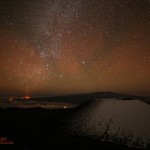Taking starscape photos last week I was surprised at the intense red glow appearing in the photographs. All across the southern sky were glowing areas of sky, here and there dark rifts cut through the glow. Set beside the Winter Milky Way it created beautiful photographs.

The airglow was intense enough to be visually seen when I stepped away from the camera and let my eyes adapt to the darkness. Away from the Milky Way, in what should be dark sky, a faint red glow pervaded. I wondered what was going on, the normal airglow over Mauna Kea is quite faint and usually very green.
I was even further surprised when I later found out that a strong geomagnetic storm was in progress that night. Kp=6 conditions from back to back CME’s were creating strong aurora over Canada and the upper US.
Was I seeing some sort of auroral glow? In Hawaii? At 20°N latitude? This did not seem likely, but something unusual was occurring!
Probably not aurora… The consensus is that what I photographed is very strong airglow. I have observed and photographed airglow before, it was the sheer brightness of this display that raised questions. I went back and reviewed many of my older photos from the summit. While airglow is common in the shots taken without moonlight. Nowhere did I see anything like this.
Airglow makes sense, but this does not end the story. A little research seems to indicate that airglow can be enhanced during strong geomagnetic activity. Several papers with observations show this correlation, and at least one I read refutes the connection. In particular a paper that used observations from Puerto Rico caught my attention…
Highly structured tropical airglow and TEC signatures during strong geomagnetic activity, M. C. Kelley, F. Garcia, J. Makela, T. Fan, E. Mak, C. Sia, D. Alcocer, Geophysical Research Letters, Volume 27, Issue 4, pages 465–468, 15 February 2000
A remarkable set of all-sky images using the 630 nm airglow emission has been taken over the Arecibo Observatory in Puerto Rico
Most surprising is that geomagnetic activity seems to greatly amplify them, forming very intricate patterns of light and dark
Several papers included mid-latitude observations of airglow during geomagnetic storms. Papers using data from tropical locations were few.
Imaging observations of midlatitude ionospheric disturbances during the geomagnetic storm of February 12, 2000, Sahai, Y.; Shiokawa, K.; Otsuka, Y.; Ihara, C.; Ogawa, T.; Igarashi, K.; Miyazaki, S.; Saito, A., Journal of Geophysical Research, Volume 106, Issue A11, p. 24481-24492
In this paper, we present observations of the OI 630 nm emission images from these two sites with a cluster of other observations during the geomagnetic storm of February 12, 2000.
Images from both Rikubetsu and Shigaraki show the presence of mesoscale-enhanced airglow bands moving slowly (~20-30ms-1) to the southwest direction.
I also reviewed the CFHT Cloudcam imagery from the night. No notable airglow seems visible. The camera looks east, my own photographs from the night show nothing in the east, the effect was strong only in the southern sky. Cloudcam does offer an interesting baseline however. Perhaps a review of imagery from other strong or stronger geomagnetic events? I will be installing a Cloudcam on Keck soon, (On another note… I should suggest to Kanoa that he go up and clean the sensor in CloudCam.)
It appears I witnessed and photographed a strong airglow display, probably enhanced during a strong geomagnetic event. The upper atmosphere is a complex place with many odd phenomena that can occur. Another reason to get out and to enjoying the spectacle of our night sky.


interesting!